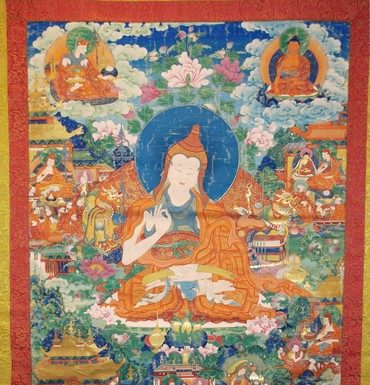Meditations on the lamrim

For a more detailed outline, audio teachings and transcripts, click here.
- Relying whole-heartedly on a spiritual master (guru)
- Advantages of properly relying and disadvantages of not properly relying on a spiritual master
- How to rely by one’s thought
- How to rely by one’s actions
- Precious human rebirth
- Eight freedoms and 10 fortunes of a precious human rebirth
- Its great value
-
Its rarity
Path of the initial being—striving for the happiness of future lives
- Recollecting death
- Death is certain to occur
- The time of death is uncertain
- Nothing except the Dharma helps at the time of death
- Considering the sufferings of the lower realms
- Hell realm
- Hungry ghost realm
- Animal realm
- Taking refuge, a safe and sound direction in life
- Causes for refuge: dread, faith, compassion
- Objects of refuge: Buddha, Dharma, Sangha
- How to take refuge: knowing the qualities etc. of the Three Jewels
- Advantages of taking refuge
- What to practice after taking refuge
- Generating confidence in the functioning of cause and effect
- General aspects of cause and effect
- Karma is definite: positive actions bring happiness, negative ones bring pain.
- The weight of karma increases as time passes.
- If the cause is not created, the effect is not experienced.
- Karmic imprints are not lost, but will ripen when conditions become favorable.
- Specific aspects
- Cause and effect of negative, destructive actions
- Factors making an action heavy or light
- Cause and effect of positive, constructive actions
- Four results that a complete action can bring
- Causes of the eight favorable qualities for Dharma practice
Path of the intermediate being—striving for liberation from cyclic existence (contemplating the four noble truths)
- General aspects of cause and effect
- Sufferings of cyclic existence
- General sufferings of samsara
- Six sufferings:
- uncertainty
- dissatisfaction
- having to die
- having to be reborn
- going up and down in the six realms
- experiencing pain by oneself alone
- Three sufferings:
- pain
- change
- pervading-compounded
- Sufferings of the three upper realms
- Human: birth, sickness, aging, death, parting from what you like, meeting what you do not like, not getting what you want, having contaminated aggregates
- Demi-god: jealousy and quarrels
- God: great suffering prior to death
- General sufferings of samsara
- Functioning of cyclic existence and the path to liberation
- Causes of suffering: how ignorance causes the other afflictions which in turn produces karma that propels us from one rebirth to the next. 12 links of dependent arising.
-
Path to liberation: the three higher trainings of ethics, concentration and wisdom
Path of the superior being—striving for enlightenment for the benefit of all sentient beings
- Advantages of the altruistic intention to attain enlightenment for the benefit of all sentient beings (bodhicitta)
- The way to develop the altruistic intention
- Seven points of cause and effect
- Equanimity of friend, enemy and stranger is the preliminary
- Seven points:
- recognizing sentient beings as your mother
- remembering their kindness
- wishing to repay it
- heart-warming love
- compassion
- great determination
- altruistic intention
- Equalizing and exchanging self and others:
- equalizing self and others,
- disadvantages of selfishness,
- advantages of cherishing others,
- exchanging self and others,
- taking others’ suffering and giving them your happiness and its causes
- Combining the above two methods into one
- Seven points of cause and effect
- Taking the bodhisattva vows
- Aspiring altruistic intention
- Engaging altruistic intention—18 root and 46 auxiliary vows
- Conduct of a bodhisattva
- Six far-reaching attitudes (perfections)
- generosity
- ethics
- patience
- joyous effort
- meditative stabilization
- wisdom
- How to develop meditative quiescence and wisdom in particular
- Special path of the Vajrayana
- Six far-reaching attitudes (perfections)
Venerable Thubten Chodron
Venerable Chodron emphasizes the practical application of Buddha’s teachings in our daily lives and is especially skilled at explaining them in ways easily understood and practiced by Westerners. She is well known for her warm, humorous, and lucid teachings. She was ordained as a Buddhist nun in 1977 by Kyabje Ling Rinpoche in Dharamsala, India, and in 1986 she received bhikshuni (full) ordination in Taiwan. Read her full bio.

